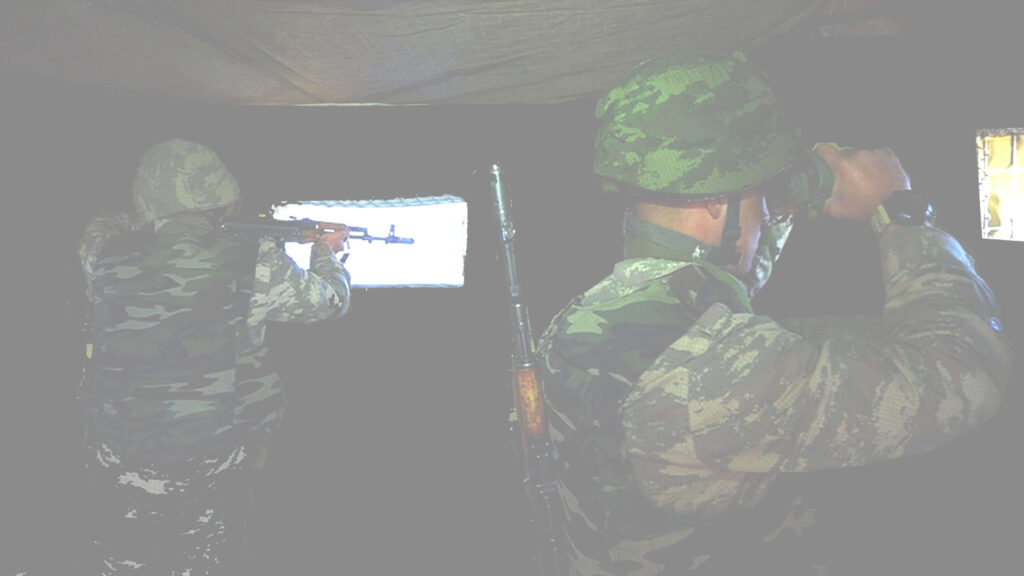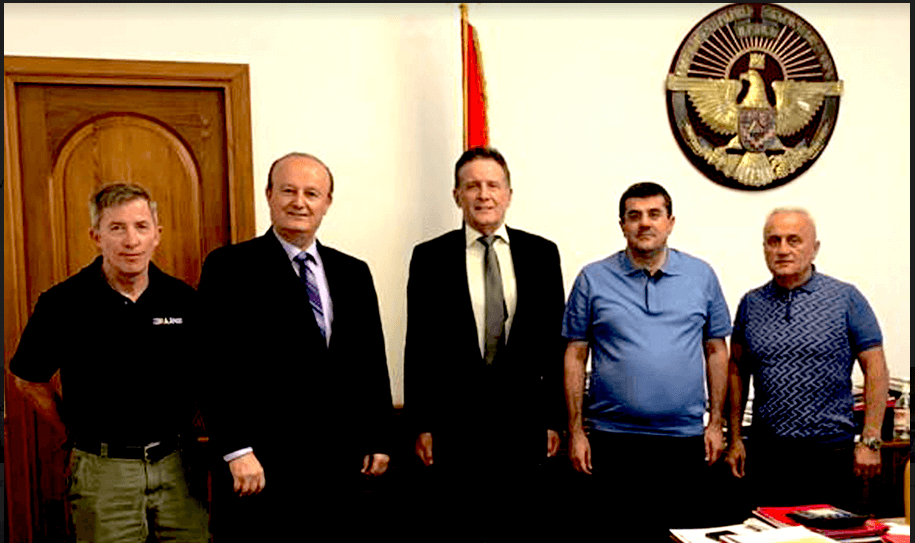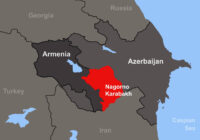In Spring 2016, Azerbaijan, an oil-rich former Soviet republic in the South Caucasus, invaded the Republic of Artsakh in a four-day conflict. Also known as Nagorno-Karabakh, this self-proclaimed independent enclave has been associated with the Republic of Armenia, a rising democracy and emerging friend of the United States. Many consider this land the ancestral homeland of the Armenian people. After Armenia and Azerbaijan declared independence from the Soviet Union in 1991, both nations fought fiercely to control this long-contested area. When a ceasefire was finally declared in 1994, Armenia had succeeded in taking control of Artsakh.
At the commencement of the 2016 conflict, retired Major General Mark MacCarley received an unexpected opportunity to measure the capabilities of the Armenian/Artsakh forces responding to the Azerbaijan incursion. His observations, interviews with senior Armenian and Artsakh military and political leaders, and subsequent research resulted in the formation of the non-profit educational organization called the American Armenian National Security Institute (AANSI). Its mission is to study the country’s warfighting doctrine and tactics and give constructive input to its Army leadership. This effort helps the Army counter Russian military influence and prepares Armenian forces to prevail in future conflicts.
My trip to Armenia as a politician (2016)
I retired from the US Army in 2015 and traveled to Armenia on April 1, 2016. Accompanied by a prominent member of the American Armenian community, I went to attempt to understand the Armenian culture and economy. I come from Glendale, California, a mid-sized suburb of Los Angeles County that is home to nearly 125,000 first-generation Armenians.

Major General (Ret) Mark MacCarley, Major General (Ret) Edward F. Dorman and Colonel (Ret) James Robinette showing respects at the Armenian Genocide Monument. Photo by Appo Jabarian.
When we began our journey to the Armenian capital of Yerevan, the Armenia–Azerbaijan War had not yet started. Although armed clashes between the two sides had sporadically erupted since 1992, after Armenia successfully supported Artsakh’s war of liberation from Azerbaijan, there was a long-standing ceasefire in place. This was monitored by the Organization for Security and Cooperation in Europe (OSCE) Minsk Commission, a non-governmental organization specifically chartered to resolve territorial and ethnic disputes between Armenia/Artsakh and Azerbaijan. This Commission consisted of representatives of the US, France and Russia. After 34 years of seemingly endless and futile negotiations, however, the Minsk Commission had not resolved any material issues separating the sparring parties.
A couple hours after I checked into our hotel in Yerevan, I received a call from the aide-de-camp to Lieutenant General Seyran Ohanyan, then-Minister of Defense of the Armenian Armed Forces. The aide-de-camp asked if I would meet with General Ohanyan as soon as possible. Literally, at that very moment, hostilities between Armenia/Artsakh and Azerbaijan had just erupted. I was initially befuddled about the identity of the caller, but after making inquiries, I agreed to the meeting. To this day, I speculate that General Ohanyan somehow became aware of my entry into Armenia that morning and erroneously assumed that I represented the “spear point” of a desired US military assistance team to Armenia.
I met with General Ohanyan at the Armenian equivalent of the Pentagon. I informed him of my recent retirement from active service with the US Army. I told him that I did not represent the US government. General Ohanyan responded that he was aware that I had twice served as one of the US Army’s senior logisticians in Kuwait, Iraq and Afghanistan. He then asked me if I would be willing to proceed to Artsakh and assess the Armenian/Artsakh army’s logistics capabilities, as it was now engaged in defending the homeland against Azeri invaders. I agreed at no charge to his government.
I remember his concluding statement to me: “You American generals, you always fly where you need to go. But, I apologize, General MacCarley. We just don’t have aircraft to fly you to Stepanakert, the capital of Artsakh. You will have to drive east through Armenia and then through the Southern Caucasus Mountains to reach Stepanakert before nightfall.”
I hired a vehicle and engaged a one-person security detail. I left a few hours later on what proved to be a challenging journey over a nearly impassable 125-mile pockmarked road to Artsakh, the epicenter of the conflict. I arrived just behind an OSCE delegation that sought to broker a ceasefire between the combatants but ultimately failed to do so. I went directly to meet the chief of staff of the Artsakh Army. As expected, he was fully preoccupied with directing defensive operations against the attacking Azeri forces.
We discussed the current situation on the battlefield. I addressed the mission given to me by General Ohanyan. The chief of staff agreed that this requested assessment might prove valuable to him as well. He wanted to know if his army had sufficient capability to sustain combat operations over a period longer than a week. That is, he wanted to know whether his army would have the required means and resources to provide its front-line soldiers with the necessities of war: food, water, ammunition, weapons, medical supplies, spare parts, fortification materials and major weapons systems, such as tanks and artillery pieces.
With the chief of staff’s concurrence, I headed to the field to conduct my assessment. Upon my return four days later, the war was over. Then-Russian Prime Minister Dmitry Medvedev had arrived in Stepanakert on April 4 and brokered a ceasefire between the two militaries, with no loss of Artsakh to Azerbaijan. Both Armenia and Azerbaijan had been Soviet client states until 1991.

Major General (Ret) Scott L. Efflandt and Major General (Ret) Mark MacCarley looking out of an Armenian Army bunker at the border with Azerbaijan. Photo by Appo Jabarian.
When I came back, I assured the chief of staff that from what I saw, the Artsakh and Armenian soldiers were the most valorous, committed, dedicated and selfless fighters one could want in an army. But as a military logistician, some things concerned me: There was an insufficient number of ground transportation vehicles and significant problems with ammunition, fuel and spare parts resupply. I had also seen remnants of drones — far less sophisticated than those employed in the subsequent 2020 conflict — that the Azeris were using advantageously against Armenian/Artsakh forces in this 2016 war.
The army even had challenges with such simple things as “field feeding.” Battlefield catering doesn’t sound significant to a war effort, unless you’re a soldier who has fought for hours without access to food or water. I saw homemade meals being delivered to the front lines by women from the local villages. While this is commendable and patriotic, it is not the most efficient and expedient way to feed hungry soldiers in combat.
Upon my return to Yerevan from Artsakh, I met with General Ohanyan and the chief of staff for the President of the Republic of Armenia. I opined that the Armenia/Artsakh Army had resorted to a Soviet Russian model of static positional defense in lieu of emphasizing maneuver, breakout and penetration. This long-standing tactic had worked extraordinarily well for the Soviets in World War II but needed to be upgraded to meet current threats and emerging military technologies. I also commented that neither Armenia nor Artsakh had developed a robust defense industrial base to produce weapons organically. Almost all armaments were imported. I observed that neither the Armenian nor the Artsakh Armies had prepositioned the necessary logistical support in sufficient quantities to sustain any long-term, high-intensity conflict.

Mother Armenia, Yerevan’s symbol of Armenian perseverance. Photo by Appo Jabarian.
To successfully wage war in the 21st century, an army has to be able to fight in all domains: land, sea, air, space and the cyber environment. It needs the capability to supply and resupply its forces at any moment under the contested conditions of intense combat. The Armenian Artsakh Army could not expect victory if the majority of its forces fought in fixed positions, resembling World War I trench lines. I suggested the military leaders of Artsakh and Armenia consider contacting NATO and the US militaries and asking for advisors to teach the Armenians Western tactics, techniques and logistics procedures. I concluded that warfare had changed over the last seven decades and Armenia/Artsakh should seek to adopt these advances in tactics and armament.
When I returned home to the US, I made a few speeches about my 2016 trip to Veterans’ posts and local Armenian American outreach organizations. I did not focus any more energy on the Armenian Artsakh problem at that time.
My return trip as a journalist (2021)
In September 2020, Azerbaijan again attacked Artsakh in the 44-Day War, reclaiming for itself most of Artsakh, including its Armenian enclaves. I attempted to return to Armenia and Artsakh in October to assess what went wrong for their armies. However, I was unable to enter the country due to a shortage of flights, COVID-19 and the Armenian government’s decision to bar foreigners from transiting into Artsakh, which was once again the epicenter of the conflict.
I couldn’t help but speculate that the Armenia/Artsakh forces had not learned from the tactical and strategic issues I had identified in 2016. This 2020 war was characterized by Azerbaijan’s adroit use of drones and tactical missiles against Armenian static positions, while simultaneously waging a cyber campaign to disrupt Armenian/Artsakh’s communications and network operations. Neither Armenia nor Artsakh had established a robust combat logistics supply chain to sustain the fight.

Armenian soldiers defending against possible border incursions. Photo by Appo Jabarian.
A few months later, I found a way to return to Armenia and Artsakh by securing press credentials. I was accompanied by Armenian American investigative reporter Appo Jabarian, publisher of USA Armenian Life magazine.
As the name suggests, the 44-Day War ended after 44 days of intense fighting, when Russian President Vladimir Putin stepped in and directed the two sides to put down their weapons. Putin forced Armenia/Artsakh to cede four-fifths of Artsakh to Azerbaijan. In exchange, the hostilities would be terminated and the Russian forces would be deployed in Armenia and Artsakh to keep the peace with Azerbaijan.
Russia also committed to policing the vehicular corridor, called the Lachin Corridor, between Armenia and Stepanakert. This two-lane road constituted the sole lifeline for transporting all goods, including food, fuel, weapons and medical supplies, to the over 150,000 Armenians inhabiting Artsakh. Artsakh’s airport had long been closed due to Azeri threats to shoot down any incoming or outgoing aircraft. There was no railroad network nor any navigable waterway to support the transit of people and goods to this contested region.
I recruited some help to accompany me on this new trip. Jabarian came, of course. Retired Colonel Robert M. Cassidy, PhD, a professor of Defense and Foreign Policy at Wesleyan College, joined me. And my son Aaron MacCarley, a documentary filmmaker, came as well. Together, we embarked on an investigative and educational journey to see what remained of Artsakh and how its armed forces had fared in the fight.
We arrived in Armenia in August 2021. As journalists, we were afforded access to some civilian and military representatives of the Armenian government. At my request, a senior member of the Armenian Army met me and agreed to discreetly help my team and me enter Artsakh over the Lachin Corridor. He said that we would be the first Western journalists to transit the Corridor since the end of the 44-Day War.
Indeed, we pushed off to Stepanakert the next day. Our journey was uneventful as we were escorted by the chief of staff to the President of Artsakh. Upon arriving in Stepanakert, we had the opportunity to interview Artsakh President Arayik Harutyunyan. After some casual conversation, he described his own recent experiences leading the Artsakh Army in the field against Azerbaijan. He criticized the US and France, both signatories to the Minsk Convention, for their collective failure to take any direct action or provide any material support to Artsakh and Armenia during the war. He said such support might have positively influenced the outcome of the war for the Armenian people.

From left to right: Colonel (Ret) Robert M. Cassidy, Appo Jabarian, Major General (Ret) Mark MacCarley, Artsakh President Arayik Harutyunyan and Artsakh President Chief of Staff General Hyusnunts. Photo by Appo Jabarian.
We did not respond to such criticisms about the alleged failure of the US and its NATO allies to send military and humanitarian aid to Armenia and Artsakh. We were journalists, not diplomats. At the president’s invitation, however, we did take the opportunity to visit the accessible sites of several vicious battles between his forces and those of Azerbaijan. We sat down with a good number of veterans of the 44-Day War and heard their stories and their opinions about why this 2020 War was lost.
After two days in Artsakh, we began our return journey to Yerevan, but not without incident. When we first entered Artsakh via the Lachin Corridor, we had received an official escort from the Artsakh chief of staff who maintained a cooperative relationship with the Russian security forces there. On exit, however, we were all by ourselves, notwithstanding the chief of staff’s promise to contact Russian border officials to allow us safe passage.
For a trip that was supposed to take no more than two hours, it took us over seven to travel the 24 miles back to Armenia from Artsakh. We were confronted and challenged by Russian border guards at every checkpoint. They insisted on detaining us, sometimes for up to an hour, to determine whether we had committed immigration violations — entering Artsakh without papers. The engagements with the Russian guards ultimately proved benign. But I will never forget how the young Russian soldiers stationed at several of the checkpoints would rest their Kalashnikov assault rifles on the side door window frame of our vehicle, muzzles aimed at our driver’s torso.
My reflection as a writer (2024)
Our journalistic mission to Artsakh resulted in some articles we penned and a YouTube documentary that we produced for our Western subscribers. But we made something of a splash in Armenia. The story of our transit through the Lachin Corridor checkpoints and meeting with President Harutyunyan circulated in local newspapers. I repeatedly stressed that it was an honor for me to execute this mission, which might improve the Armenian armed forces. If that is the outcome of my two journeys to Artsakh, then my efforts in the face of some risk and mildly difficult conditions were justified.
Jabarian’s photos capture the culture and excitement we experienced. Armenia and Artsakh are fascinating places. Sadly, Azerbaijan overran Artsakh in 2023, although a government-in-exile still exists. I hope that Armenia develops greater defensive strategies so it can endure against future Azeri threats.
[Lee Thompson-Kolar edited this piece.]
The views expressed in this article are the author’s own and do not necessarily reflect Fair Observer’s editorial policy.
Support Fair Observer
We rely on your support for our independence, diversity and quality.
For more than 10 years, Fair Observer has been free, fair and independent. No billionaire owns us, no advertisers control us. We are a reader-supported nonprofit. Unlike many other publications, we keep our content free for readers regardless of where they live or whether they can afford to pay. We have no paywalls and no ads.
In the post-truth era of fake news, echo chambers and filter bubbles, we publish a plurality of perspectives from around the world. Anyone can publish with us, but everyone goes through a rigorous editorial process. So, you get fact-checked, well-reasoned content instead of noise.
We publish 2,500+ voices from 90+ countries. We also conduct education and training programs
on subjects ranging from digital media and journalism to writing and critical thinking. This
doesn’t come cheap. Servers, editors, trainers and web developers cost
money.
Please consider supporting us on a regular basis as a recurring donor or a
sustaining member.
Will you support FO’s journalism?
We rely on your support for our independence, diversity and quality.








Comment